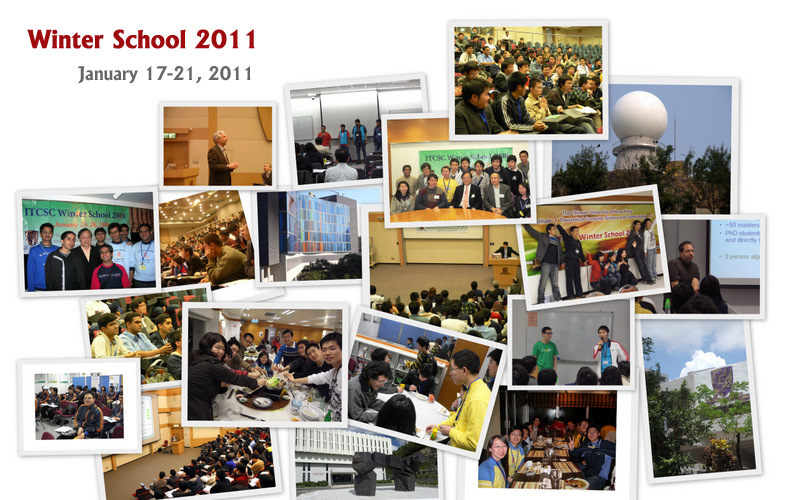| |
Jan 16 (Sun) |
Jan 17 (Mon) |
Jan 18 (Tue) |
Jan 19 (Web) |
Jan 20 (Thu) |
Jan 21 (Fri) |
9:30am
-
11:30am |
|
Probabilistic Methods (part 1)
By
Prof. LAU Chi Lap |
Probabilistic Methods (part 2)
By
Prof. ZHANG Shengyu |
Information Theory and Channel Coding (part 1)
By
Dr. Amin Aminzadeh Gohari |
An Introduction to Network Coding
By
Prof. Raymond YEUNG |
Hong Kong Excursion |
|
Lunch 12:00 - 2:00 pm |
2:00pm
-
4:00pm
|
Registration at Regal Riverside hotel |
Error-correcting Codes
By
Prof. Sidharth JAGGI |
Fast decoding using graphs and randomness
By
Prof. Andrej BOGDANOV
|
Information Theory and Channel Coding (part 2)
By
Prof. Chandra NAIR
| Problem Session
|
| |
5:30pm |
Group Photo |
6:00pm |
|
Closing Dinner |
| |
| Jan 17 |
Probabilistic Methods (part 1) By Prof. LAU Lap Chi |
| |
We will introduce the basic ideas of using probabilistic methods to construct combinatorial objects, e.g. Ramsey graphs, error correcting codes, etc.
Lecture notes
Exercises for Probabilistic Methods
|
| |
Error-correcting codes By Prof. Sidharth JAGGI |
| |
What if you want to transmit information over a noisy channel -- what strategies would you use?
The challenge is to generate combinatorial structures which are sufficiently rich so as to be able to
support communication at high rates, and yet are simple enough to lend themselves to efficient construction
and implementation. In this discussion-based session we'll construct efficient codes that have performance
that's not too far off from corresponding bounds that we'll also prove. See the handout below for the worksheet
that'll be used.
Error-correcting codes handout
|
| Jan 18 |
Probabilistic Methods (part 2) By Prof. ZHANG Shengyu |
| |
Fast decoding using graphs and randomness By Prof. Andrej BOGDANOV |
| |
Suppose you designed an error correcting code and you use it to send a message to your friend. But the message is corrupted during transmission. How should your friend go about recovering it? In general, the more errors there are, the harder it becomes to recover the message. But if we design the code carefully, it turns out that we can correct transmission errors much much faster. I will show you a simple design that uses some graphs, randomness, and basic linear algebra.
Lecture notes
|
| Jan 19 |
Information Theory and Channel Coding By Dr. Amin Aminzadeh Gohari and Prof. Chandra NAIR |
| |
In this lecture we will introduce concepts from information theory with the main objective being the proof of Shannon's celebrated channel coding theorem. The concepts of entropy and mutual information will be introduced, and we will develop the necessary mathematical tools in the first half of today's lecture.
In the second half of this lecture we will state Shannon's communication model, and establish the channel capacity. The argument will use the probabilistic method introduced in Monday's lecture.
Lecture notes
|
| Jan 20 |
An Introduction to Network Coding By Prof. Raymond YEUNG |
| |
In recent years, network coding has generated much interest in information theory, coding theory, networking, wireless communications, cryptography, and computer science. Consider a point-to-point communication network on which a number of information sources are to be mulitcast to certain sets of destination nodes. The problem is to characterize the maximum possible throughputs. Contrary to one's intuition, network coding theory reveals that it is in general not optimal to regard the information to be multicast as a "fluid" which can simply be routed or replicated. Rather, by employing coding at the nodes, bandwidth can in general be saved. In this tutorial, we give an introduction and an overview of the subject.
|
| |
| |

